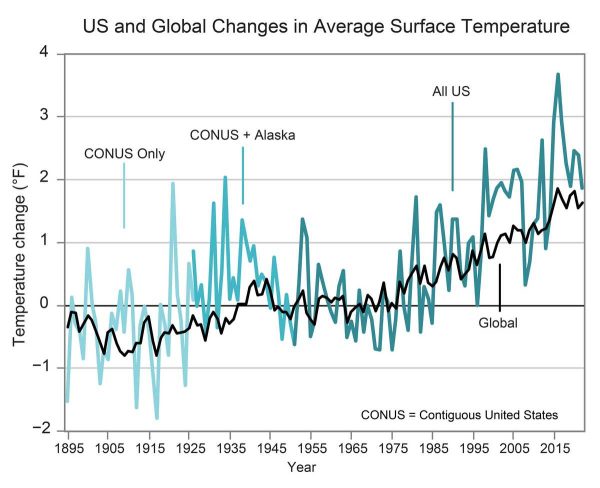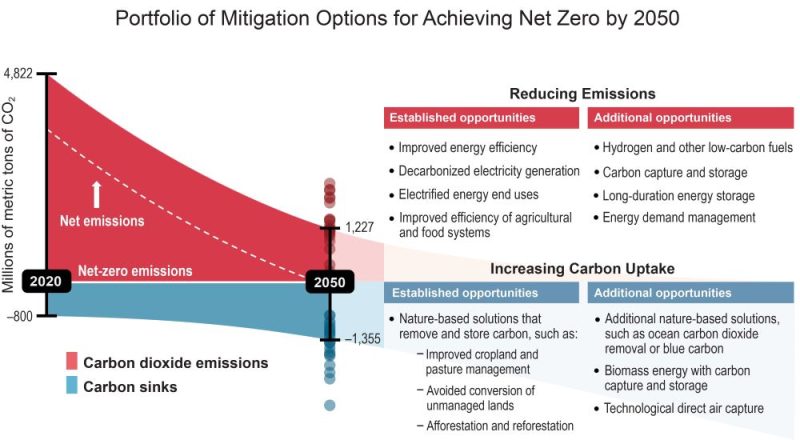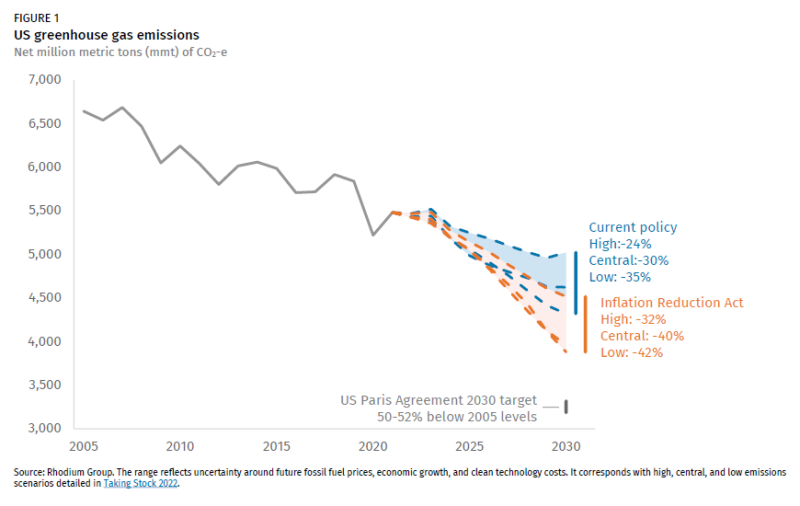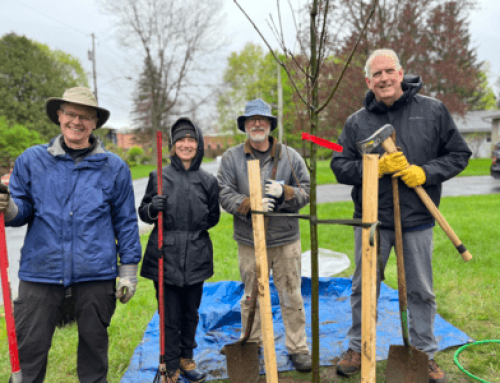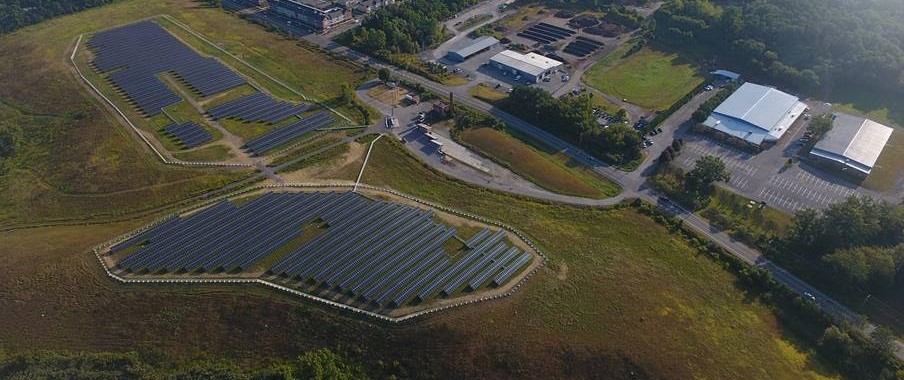
The Spa Solar Park in Saratoga Springs, NY
Climate of Hope: The Fifth National Climate Assessment Finds that Impacts are Accelerating but Policy Interventions are Starting to Make a Difference
By Jared Snyder
Hope or despair, that is the question, as William Shakespeare might say if he were writing today. It seems that each day brings more news, articles or books about the worsening impacts of climate change. Much of this news is dire: devastating wildfires, record heat making outdoor work dangerous in some places, and damaging floods, both riverine and coastal. But at the same time, robust action is underway in both the public and private sector to reduce greenhouse gas emissions and mitigate the impacts. The jury is still out, however, whether this action will measure up to the challenge and how durable it will be in these uncertain times.
In late 2023, the federal government issued the Fifth National Climate Assessment, fulfilling the requirement of the Global Change Research Act of 1990 that the federal government issue periodic assessments of “global change” informed by the most up-to-date scientific knowledge. The primary focus of the Assessment, as required by the legislation, is on the impacts being observed and projected for the future. But the Assessment also documents the state of response actions at federal, state and local levels, including both adaptation and mitigation.
The Assessment’s conclusions are not surprising to anyone familiar with the day-to-day news of record temperatures and increasing frequency and magnitude of disasters associated with the changing climate such as wildfires and intense storms. But not all news is bad; the Assessment also documents that governments at all levels are stepping up efforts to both reduce emissions and adapt to the impacts experienced now and projected in the future.
The Assessment’s Overview provides a good comprehensive summary of the report and is worth a read. For those short of time, this post provides a summary of some of the highpoints.
The bottom line is that as global emissions increase, temperatures are rising and risks from extreme events are increasing.
The report documents that US and global temperatures have increased significantly since the 1970s, as illustrated by this graph:
Notably, the report was published before the most recent temperature data documented that 2023 was by far the hottest year ever experienced.
The impact of extreme events has outpaced the increase in temperatures. Between 2018 and 2022, the nation experienced 89 weather-related events causing over $1 billion in damages, an average of one such event every three weeks. That is in contrast to the 1980s, when the nation experienced billion dollar events (adjusted for inflation) every four months on the average. Wildfires, heat waves, severe storms and other events also caused a dramatic loss of life. For example, 1400 lives were lost to the 2021 heat wave in the Pacific Northwest.
As might be expected, the report finds that climate change exacerbates inequalities, causing greater impacts in low-income communities and communities of color. In part, that is due to the urban heat island impact, which results in significantly higher temperatures in these areas, up to 12 degrees Fahrenheit hotter than in nearby wealthy communities with more green spaces. The inequities are exacerbated by poorer, less climate-ready housing in lower-income communities. In addition, these disadvantaged communities are often located in lower-lying areas more vulnerable to flooding.
The report includes a chapter focused on climate impacts in the northeast, primarily increased frequency and magnitude of extreme precipitation, which has accelerated more in the northeast than anywhere else in the country, a pattern that’s expected to continue. Extreme heat events have also been on the rise in the Northeast, primarily in the larger urban areas, and are likely to increase in the future.
United States’ emissions are declining, but not fast enough.
The assessment finds that US emissions decreased 12% from 2005 to 2019, an average annual decline of approximately 1%. That reduction is attributable primarily to a 40% reduction in emissions from electricity generation, due largely to the replacement of coal-fired power plants with natural gas and renewable sources, stimulated in part by dramatic reductions in the cost of wind and solar power. But other sectors are not seeing the same level of emission reductions.
Although reducing emissions is better than the alternative, it is nowhere near fast enough to prevent the worst impacts of climate change. The report finds that the annual rate of emission reductions must increase dramatically to at least 6% annually in order to meet the national goal of net zero emissions by 2050.
The good news is that most of the necessary technologies to meet this goal – e.g. solar and wind power, battery storage, heat pumps and electric vehicles — are available now and innovation is resulting in new technologies in all sectors to support the needed emissions reductions. But more development and advancement of emerging technologies like green hydrogen and direct air capture will also be needed to meet this goal, as illustrated by the graph below:
Thankfully, climate action is taking place across the country.
A somewhat surprising conclusion of the report, given the deep partisan divides in the country, is that climate action is taking place everywhere. Of course, more emission reduction efforts are underway in leading states including New York, California and Massachusetts but action is also underway in more conservative states like Texas and Florida, often at the municipal level. Indeed, Florida’s cities are among the leaders among municipalities. Although most states are taking some steps to build resilience and adapt to climate change, it is significant that state action does not seem to be related to the amount of impacts being realized in many states. For example, Texas and Florida are experiencing some of the greatest monetary damages from extreme events but their adaptation efforts pale in comparison with those underway in the Northeast and California.
At the federal level, the Inflation Reduction Act is driving the deployment of emission reduction technologies that are beginning to bear fruit. Those efforts are complemented by federal regulatory efforts such as the vehicle emission standards finalized in the spring of 2024 and continued state and federal action. Collectively, these actions are projected to drive a decline in emissions potentially approaching the Biden Administration’s commitment to 50-52% reduction from 2005 levels by 2030, as illustrated in a separate report prepared by the Rhodium Group: Taking Stock 2023: US Emissions Projections after the Inflation Reduction Act.
Although implementation of the Inflation Reduction Act is helping to bend the emissions curve, the job is far from done. If we are to have any chance of meeting the science-based goal of limiting global temperature increase to 1.5 degrees Celsius, action at all levels of government and in the private sector must not only continue but accelerate.
At the federal level, continuing implementation of the Inflation Reduction Act for the foreseeable future must remain a priority, but it should be seen as the foundation for further federal action, not the ceiling. Crucially, United States leadership is essential to motivate and stimulate action elsewhere in the world.
State action is also essential but it must expand beyond the blue states on the coasts, upper Midwest and southern Rockies, to all 50 states. Supported by federal funding under the Inflation Reduction Act, 45 states have prepared priority climate plans for implementation, even if many of those eschew use of the word “climate.” For now, many of those states may limit implementation to actions funded by the Inflation Reduction Act but the hope is that this seed funding will help those states develop a taste for climate action.
Local action is also an important piece of the puzzle. Saratoga Springs’ development of a climate action plan is just one local example that addressing climate change can be a nonpartisan enterprise. Although many businesses are coming to the realization that climate action makes good business sense, their investment decisions will continue to be informed by expectations about the future regulatory framework. Before they make the transformative investments necessary in many carbon-intensive industries, corporate boards seek confidence regarding the continuity of regulatory frameworks that value clean energy and emission reduction.
Finally, individual decisions we all make on a daily basis also have a role to play, from the cars or appliances we buy to whether to walk, bike or drive to work, school or shopping. Our actions, including how we vote, can help build hope for a sustainable future.
Jared Snyder was the Deputy Commissioner for Climate, Air and Energy at the New York Department of Environmental Conservation from 2007-2022. Since then, he has lectured at Skidmore College about climate policy and participated on Sustainable Saratoga’s Climate and Energy Committee. He is a Board member of the New York League of Conservation Voters.


